What a Better Tax Bill Would Look Like

This year presents an opportunity to enact tax policy changes that would ease the strain on household budgets that people in low-paid jobs and their families face and allow them to invest in their future, while ensuring that the nation’s wealthiest pay more of their fair share in taxes. Expiration is approaching for a number of provisions in the 2017 tax law — which showered expensive tax cuts on the wealthy and failed to deliver on promised benefits for economic growth and workers’ earnings — so the time is ripe for a new direction.
But the economic agenda the Trump Administration and congressional Republicans are pursuing would double down on the 2017 law’s flaws by extending its skewed taxed cuts, which would further balloon deficits and deliver another trickle-down failure. And to help pay for those tax cuts, House and Senate Republicans are planning massive cuts that would take health care and food assistance away from, and make college less affordable for, millions of people with low and middle incomes.
Republicans should instead pursue one of the paths they campaigned on, as articulated by Senator Josh Hawley in January: “for every Republican who has hailed the new working-class coalition that President Trump has assembled, this is the time to deliver.”
A better tax bill would:
- Not take health care and food assistance away from millions of people or make it harder to afford college or pay energy bills.
- Prioritize tax credits that help people make ends meet as they face rising costs for groceries, clothes and other retail goods, health care, and other items:
- expand the Child Tax Credit in a way that prioritizes the 17 million children in families who get less than the full credit because their families’ incomes are too low;
- permanently extend the larger premium tax credits that are helping people afford health coverage;
- and expand the Earned Income Tax Credit (EITC) for adults in low-paid jobs not raising children at home, including young adults just starting out who may be struggling.
- Require corporations and the wealthy to pay a fairer share of tax, which will also help offset any of these tax cuts. This includes ending tax cuts for high-income people on schedule, raising taxes on very wealthy people and corporations that receive enormous breaks under the current tax code, and building an IRS capable of collecting more of the taxes that are already legally owed.
And whether as part of the tax bill or separately, Republicans in the majority should also assert Congress’ constitutional power and responsibility over trade policy and turn off the destructive tariffs the Trump Administration has imposed and threatened. Separate bills introduced by Republican and Democratic Senators and Democratic House members are a step in the right direction. The Administration’s tariffs will hit low- and middle-income families particularly hard at grocery and retail stores while risking a global recession, with all the human suffering that entails.
Don’t Take Away Health Care, Food Assistance, and College Support
One easy course correction toward crafting a better tax bill would be for Republicans to simply not harm the low- and middle-income people they campaigned on helping. But the Republican budget resolution includes instructions to House committees to make $1.4 trillion in cuts to programs in their jurisdiction that could potentially harm low- and middle-income people. These include instructions to the committee with jurisdiction over Medicaid to cut at least $880 billion over ten years, the committee with jurisdiction over food assistance through SNAP to cut $230 billion, and the committee with jurisdiction over student loans to cut $330 billion. These programs serve tens of millions of people: Medicaid provides health coverage that 72 million people count on; SNAP helps over 40 million people put food on the table each month; and student loans make higher education more affordable for millions of people. The Republican budget resolution may also assume cuts to energy tax credits and other climate investments, which would increase utility bills, imperil energy reliability, and threaten jobs and investment nationwide.
Even cuts that are a fraction of the size of the potential $880 billion cut to Medicaid and $230 billion cut to SNAP in the House instructions would cause serious harm. They would still increase costs for strapped families and leave more people uninsured and unable to afford food. And it is possible the cuts will be deeper or cover more areas, as some House and Senate members press for far larger cuts.
These cuts are all designed to help offset the cost for wasteful, $1.8 trillion tax cuts for people in the top 5 percent of incomes. (See Figure 1.)
Figure 1

At the same time the Republican agenda would raise costs for families and leave more people uninsured, the Trump Administration’s tariffs threaten volatility and price increases — and a significantly increased risk of recession and higher unemployment — that will land hardest on people who can least afford it.
Expand the Child Tax Credit and EITC, Extend Enhanced Premium Tax Credit
The 2017 tax law included some structural improvements: it doubled the standard deduction and the maximum Child Tax Credit amount while eliminating the personal exemption. These changes cut taxes for most people with low and moderate incomes, though only modestly, while simplifying the tax returns of millions of taxpayers as they reduced the number of those who need to itemize their deductions. But these changes provide only modest help to many low- and moderate-income families and more is needed in a tax bill to help families afford the basics, including the cost of health care.
Child Tax Credit
The Child Tax Credit is key in helping millions of families afford the essentials, and lifted 3.6 million people, including 2.0 million children, above the poverty line in 2023. But one of its greatest design flaws is that under the 2017 tax law, it leaves 17 million children, or roughly 1 in 4 children, out of receiving the full credit because their parents’ incomes are too low. While most of the children left out of the full credit receive a partial credit, children in families without income in a given year, for reasons including job loss, health, and caregiving responsibilities, don’t receive any credit at all.
While the 2017 tax law doubled the maximum Child Tax Credit amount from $1,000 to $2,000, millions of children in families with low and moderate incomes — those who would most benefit from an increase — didn’t receive that full increase the way that children in families with higher incomes did. In fact, millions received a Child Tax Credit increase of just $75 or less from the 2017 tax law, far below the $1,000-per-child increase that higher income families received.
A better tax bill would fix these flaws. The best and simplest way to do that is to provide the full Child Tax Credit amount to all children in families with low and moderate incomes. This is often called making the credit “fully refundable,” because families whose credit exceeds their income tax liability receive the full credit as a refund. As one example, the American Family Act, recently reintroduced in the House by Rep. Rosa DeLauro and others and in the Senate by Sen. Michael Bennet and others, would do just that, while also increasing the maximum credit, paying it on a monthly basis, and providing a larger amount during the first year of a child’s life, among other changes.
Making the credit fully refundable would have important benefits for children in families with lower incomes. When this feature and other key expansions, including a larger maximum credit and advance monthly payments, were in effect for the credit in 2021, low-income families used the money to pay for necessities like food and housing, as well as expanding educational opportunities for their children, like through tuition and after-school programs.
And the 2021 expansion, together with other pandemic relief, helped drive down the number of children experiencing poverty to a historic low in 2021. Black, Latino, and American Indian and Alaska Native children, whose families face structural racism in the nation’s economic, housing, and educational systems that depresses their earnings, experienced particularly large decreases in child poverty. But when the credit’s temporary expansions and other pandemic-era assistance expired, child poverty rates rose back up. (See Figure 2.)
Figure 2
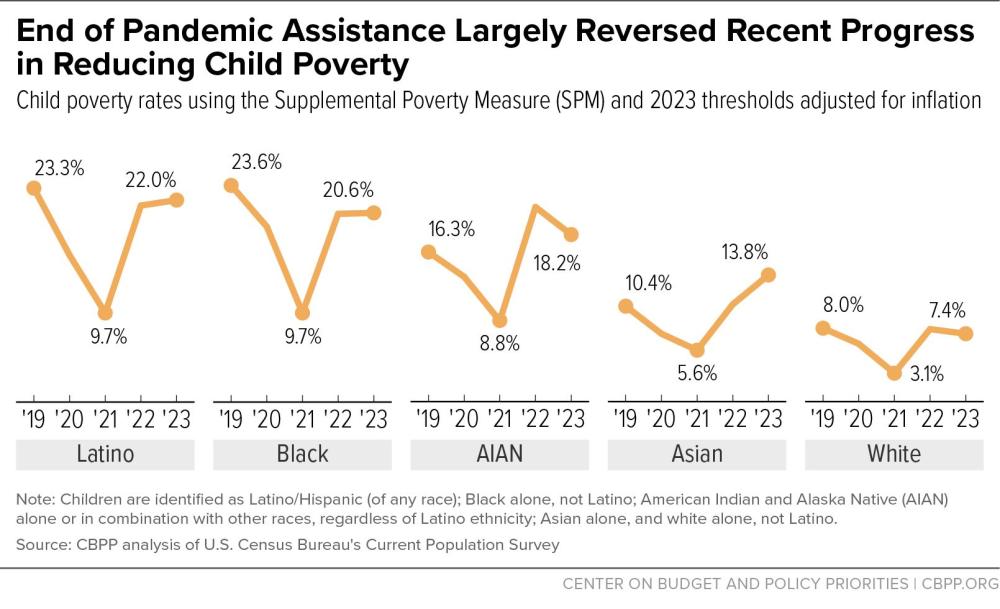
If Republicans fail to make the full credit available to the 17 million children in families whose earnings would otherwise be too low to qualify for it, they should, at minimum, expand the credit for the millions of children who receive some but not all of the credit, similar to the approach taken by the bipartisan bill from January 2024. Fully 169 House Republicans voted for that legislation, which was negotiated and championed by House Ways and Means Chair Jason Smith. In its first year, the bill would have expanded the Child Tax Credit for more than 80 percent of the children left out of the full credit, boosting the credit for children in working families. When fully in effect, it would have reduced the number of children experiencing poverty by 500,000. The expansion would have helped parents across the country who work in important occupations for low pay. (See Table 1.)
One critical reform in that legislation — which should be a top priority in the upcoming tax bill — would have allowed families with low and moderate incomes to receive the same-sized credit for each of their children. As it stands, higher-income families get the same credit amount per child; lower-income families do not. The bill would have changed this by providing the credit on a per-child basis for families with low and moderate incomes just as it is presently provided per child for higher-income families, providing substantial help to the three-quarters of children left out of the full credit who live in a family with more than one child. The bill also would have increased and eventually eliminated the lower maximum credit amount that applies to families with lower incomes, often called the “refundability cap.” This improvement would allow eligible parents to receive an increase in their credit for any increase in their work earnings, which is inexplicably denied in current law. Policymakers could improve on these bill changes by also phasing in the credit from the first dollar of a family’s earnings, as many Republicans have proposed in the past.

Enhanced Premium Tax Credits
Another tax policy key to working families that is missing from Republicans’ current agenda is extending the enhanced premium tax credits (PTCs). The enhanced credits are critical to making health coverage in the Affordable Care Act (ACA) marketplace more affordable to millions of people — and small business owners — across the country. The enhanced PTCs spurred record enrollment in ACA marketplace insurance and contributed to record low uninsured rates. (See Figure 3.) If Congress fails to extend them, health care premiums are going to surge by an average of 79 percent for over 20 million people.
Figure 3
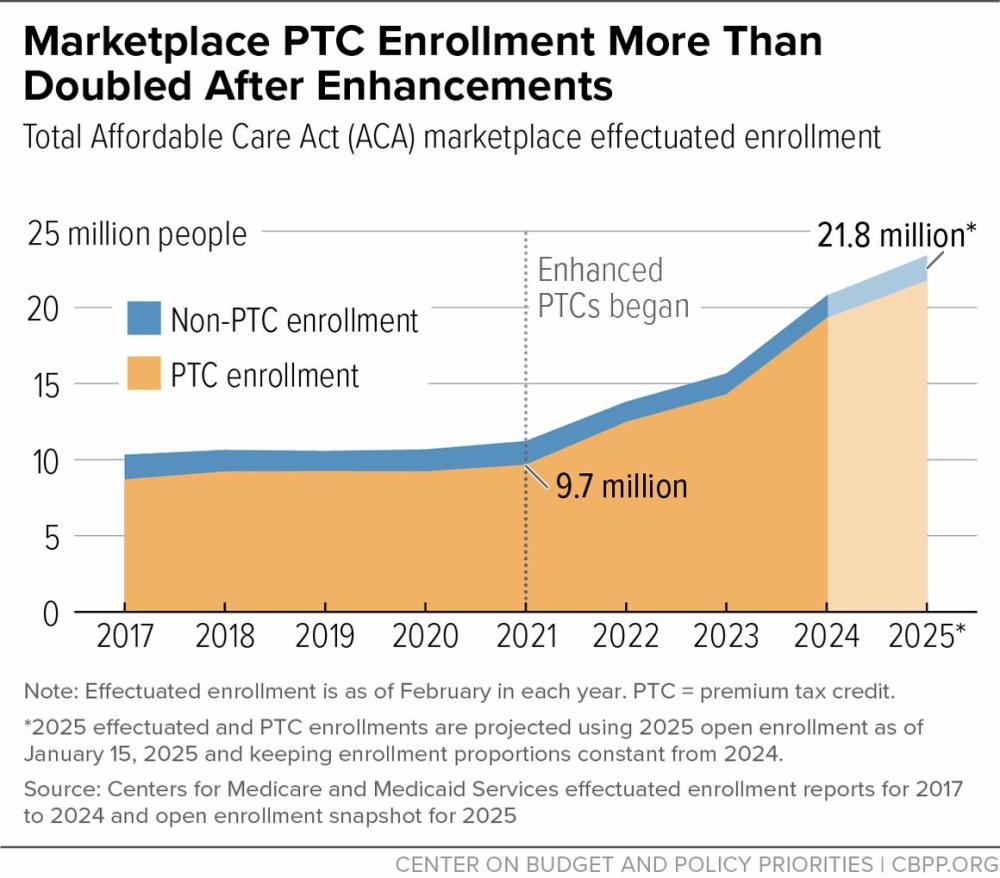
For example:
- A single individual making $32,000 (212 percent of the poverty level) would see their monthly marketplace premium more than double, from $66 to $163 — an annual increase of $1,162.
- A family of four making $65,000 (208 percent of the poverty level) would see their monthly marketplace premium increase from $126 to $324 — an annual increase of about $2,400. (See Figure 4 for the premium increases that a family of four would experience at different income levels.)
Figure 4
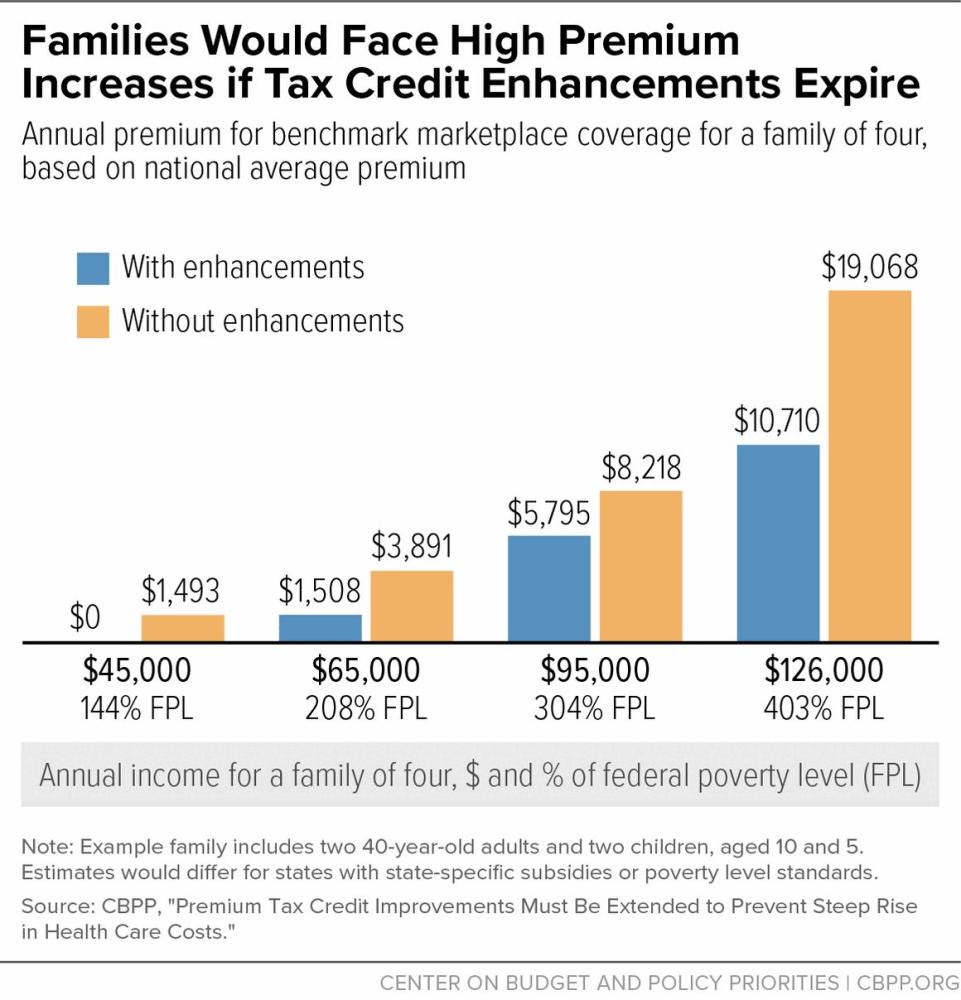
Facing dramatic spikes in their premiums, families would be forced to make hard decisions about their health coverage. Roughly 4 million people would become uninsured. As a result, they would be more likely to forgo necessary care or to incur medical debt.
When it comes to small businesses, the contrast between readily available policy options is stark. On the one hand is House Republicans’ focus on extending the 20 percent pass-through deduction and the estate tax exemption at its current very high level; both are billed as helping small businesses but in reality overwhelmingly benefit the wealthy. Extending the enhanced PTCs, meanwhile, would prevent 2.7 million small business owners who get coverage through the ACA marketplaces from facing a steep hike in health coverage costs. A better tax bill would match the rhetoric to the reality and extend the enhanced PTCs.
Earned Income Tax Credit
Then-candidate Trump’s campaign focused attention on the economic circumstances of young men, especially those who don’t go to college. But neither President Trump nor Republican members of Congress have advanced policies to date that would meaningfully help them. If Republicans truly want to help young adults, there is an easy opportunity for them to seize. Young adults in lower paying jobs who aren’t raising children at home are one of the groups largely left out of the policy success of the Earned Income Tax Credit (EITC), a policy that has intellectual origins with conservative economist Milton Friedman. These young adults do not qualify for any EITC until they turn 25, which means they miss out on critical support as they are trying to get a toe-hold in the labor market, often in low-paying, entry-level jobs. This also disproportionately harms Black and Indigenous young people, who are more likely to work in low-paying jobs due to past and present hiring discrimination, inequities in educational and housing opportunities, and other sources of inequality.
But just making these young adults eligible for the EITC isn’t enough, because the maximum credit amount for adults without children at home who are currently eligible is very small, and the income range for people to qualify is too limited. Under the current EITC, more than 6 million working adults age 19 and older who aren’t raising children at home will be taxed into, or deeper into, poverty by federal income and payroll taxes in 2026 if these changes aren’t made. Republicans should change the qualifying age range to include young people as well as adults aged 65 and older, increase the current paltry maximum credit amount for these adults not raising children, and expand the income range for people to qualify. These changes were made temporarily in 2021, and if they had been continued in 2026, they would increase the credit for an estimated 14.5 million adults working in various occupations for low pay, including an estimated 529,000 cooks, 358,000 truck and delivery drivers, and 269,000 construction workers. (See Table 2.)

Pay for the Tax Cuts by Requiring the Wealthy and Corporations to Pay a Fairer Share
The 2017 tax law was skewed in favor of wealthy people, failed to deliver on its economic promises, and was extremely costly. Combined with other failed trickle-down tax cuts that preceded it, first enacted under President George W. Bush, the erosion in revenue has been severe. Revenue as a share of GDP fell from about 19.5 percent in the years immediately preceding the Bush tax cuts to just 16.3 percent in the years following the Trump tax cuts, though the Congressional Budget Office (CBO) expects revenue to rise modestly to 17.1 percent of GDP in 2025. In dollar terms, the difference is stark: revenues would be roughly $700 billion higher in 2025 if they were still at 19.5 percent of GDP, as in the years before the Bush tax cuts. Policymakers who support lowering deficits should seek to raise revenues as part of a sound approach to address them.
Instead of addressing this revenue erosion, the Republican budget resolution puts the upcoming tax bill on a track to compound these fiscal policy mistakes. Two steps they are taking stand out in their fiscal irresponsibility. First, the Senate would adopt, for the first time ever, a “current policy” baseline which would pretend $3.8 trillion of tax cuts do not exist. Budget law generally requires that the cost of bills that change tax and entitlement laws be evaluated by comparing revenues and costs under the legislation to their costs under the law if the legislation were not enacted. Under current law these trillions of dollars in tax cuts will expire, so extending them will cost that amount. But congressional Republicans are assuming these tax cuts will be continued and that therefore they cost nothing, fooling nobody.
Second, the Senate reconciliation instructions allow the Finance Committee to write a tax bill that adds $1.5 trillion to the underlying $3.8 trillion cost. In other words, the instructions effectively add $5.3 trillion to deficits over the nine-year period 2026-2034 (the 2017 tax cuts do not expire until the end of 2025). This would be even more fiscally irresponsible than the original 2017 tax law. (The House bill allows the Ways and Means Committee to write a bill that adds $4.5 trillion to deficits, assuming a current law baseline.)
A better tax bill would instead be fiscally responsible. It would measure the true costs of the bill using the always-used-before current-law baseline and it would be fully paid for. This should be accomplished in two steps. First, tax cuts for high-income people, who did not need them in 2017 and don’t need them now, would expire on schedule. Second, the costs of expansions in tax credits for people with low and middle incomes, and any extensions of the 2017 tax cuts for people who aren’t wealthy, would be paid for by having wealthy people and corporations pay a fairer share of tax, including taxes that are legally owed yet go uncollected.
By taking these two steps, a better tax bill would result in much lower budget deficits than the upcoming reconciliation bill prescribed under the Republican budget resolution. Achieving more fiscal responsibility in this way is also far preferable to taking away people’s health care and food assistance, increasing the cost of college, and imposing substantial tariffs (effectively tax increases), which are all changes that would fall most heavily on low- and middle-income families.
Let the Tax Cuts for Wealthy People Expire
Our country has large budget deficits and glaring unmet needs, and has experienced decades of lopsided economic growth. People with incomes in the top 10 percent now account for about half of overall consumption, and wealth is highly concentrated at the very top. Wealthy people do not need more large tax cuts.
Instead Republicans should reverse the tax cuts for wealthy people and allow the individual and estate tax cuts to expire as scheduled. If the tax cuts were reversed for anyone with income above $400,000, for example, it would more than halve their cost, dropping it from $4.2 trillion to $1.8 trillion over ten years (2026-2035), according to estimates from the Treasury Department. (See Figure 5.)
Figure 5
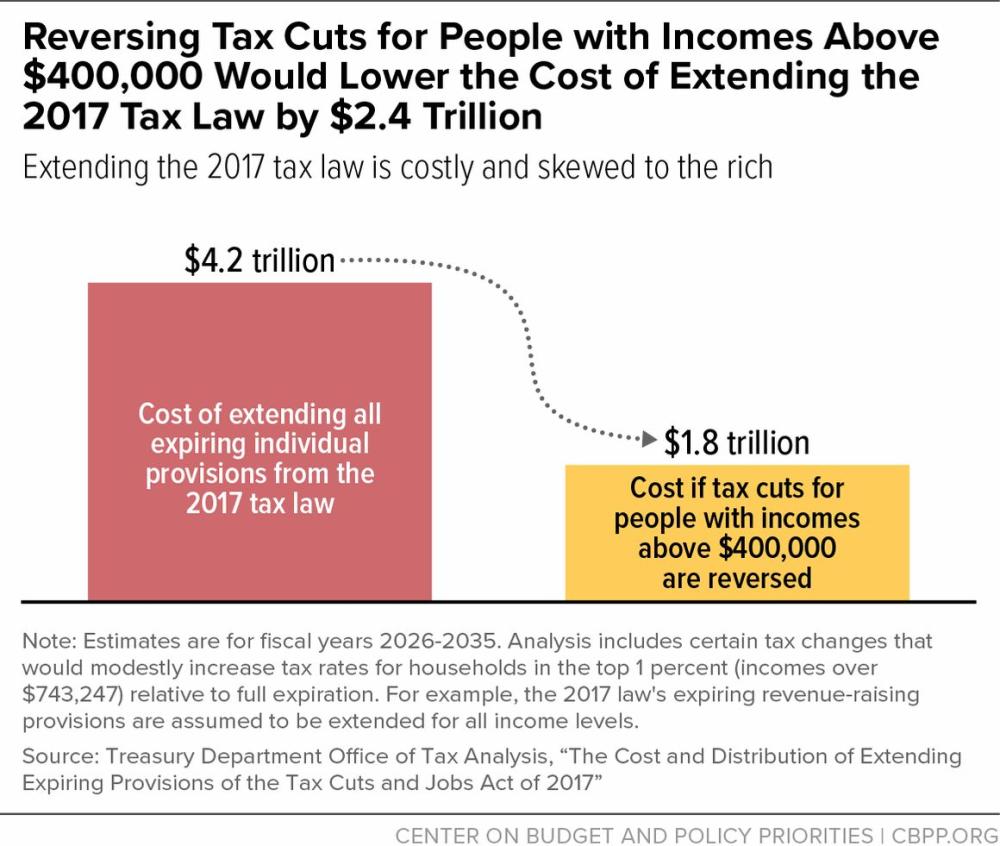
This is a far better approach for reducing the cost of a tax bill than the main offsets the Trump Administration and congressional Republicans are planning to rely on for their wasteful, regressive tax cuts: large cuts to programs that help people afford food and medical care, as well as enormous, sweeping tariffs on imported goods. The tariffs Trump announced through April 15 would offset a roughly similar percentage of the cost of extending the tax cuts (65 percent) as reversing the tax cuts for households making over $400,000 (57 percent), but would leave most families worse off, while preserving large tax cuts for the wealthy. (See Figure 6.)
Figure 6
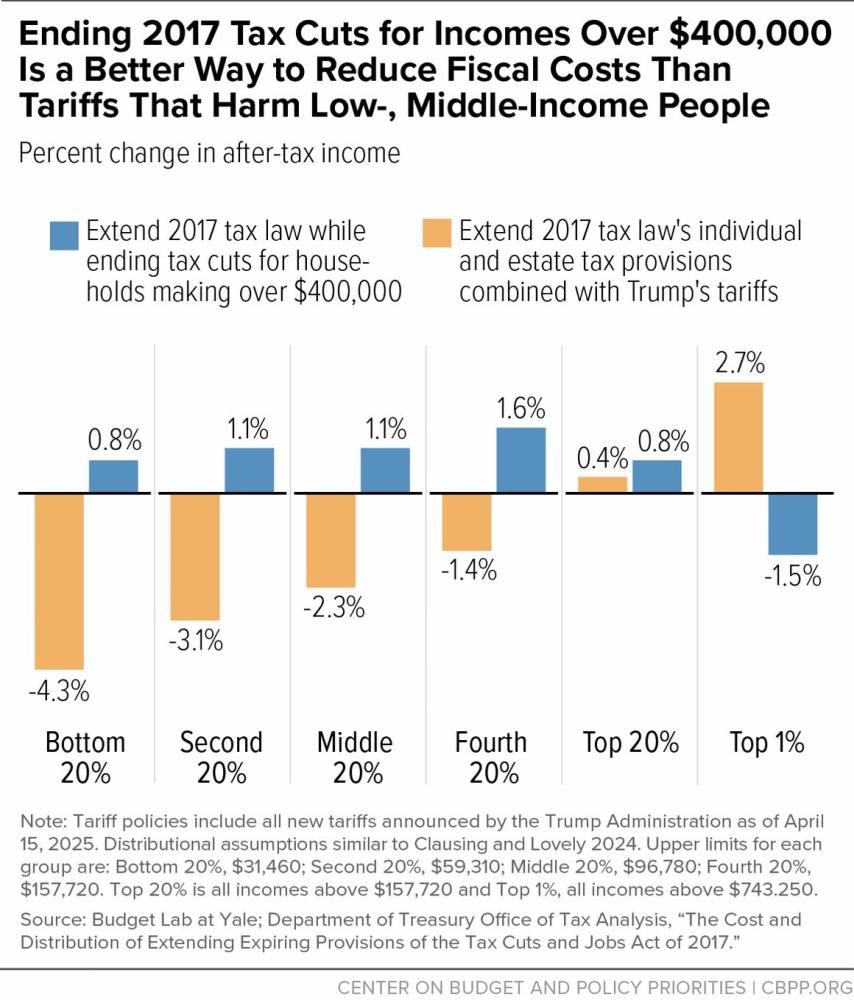
Provisions to Raise Revenue and Promote Fairness
Moreover, sound tax policies are readily available for Republicans to pay for tax cuts. That is true even when including the $1.8 trillion ten-year cost of extending the tax cuts for people making under $400,000, and the roughly $600 billion ten-year cost for the following: changing key features of the House-passed expansion of the Child Tax Credit, extending the enhanced PTCs, and expanding the EITC for working adults not raising children.
Revenue should come from three main sources:
-
Scaling back the 2017 law’s corporate tax cuts and strengthening the international tax regime. The centerpiece of the 2017 tax law was a deep, permanent cut in the corporate tax rate from 35 percent to 21 percent — a deeper cut than what the corporate community had even lobbied for. The promised economic benefits of that rate cut failed to materialize and the revenue raisers were flawed; policymakers should revisit both in a better tax bill. Raising the corporate rate to 28 percent — halfway between the current rate and the pre-2017 rate — as the Biden Administration proposed would make the tax code more progressive while raising around $1 trillion over ten years (2025-2034).
Relatedly, Republicans reportedly want to reverse certain corporate provisions in the 2017 law that were specifically designed to raise revenue to offset some of the cost of that law’s deep corporate rate cut. The provisions are often mischaracterized as “extenders.” Any effort to reverse these corporate tax increases is another reason to simultaneously reverse the corporate tax rate cut they were designed to offset.
The 2017 law’s international tax rules also require reforms to better deter costly profit shifting and to better align with the global minimum tax agreement that the United States and more than 130 other nations signed in 2021. The 2017 law exempted certain foreign income of U.S. multinationals from U.S. tax and added a minimum tax on certain foreign profits to try to limit incentives for foreign profit shifting. The 2017 law’s international provisions have serious design flaws, however, and leave significant room for multinationals to avoid taxes by shifting their profits to low-tax countries. The Biden Administration proposed reforms to international tax rules that would address these flaws and would raise around $600 billion over ten years (2025-2034) from large multinational corporations, according to the Treasury Department.
-
Requiring the wealthiest people to pay some annual income tax and reducing some of the special tax breaks they enjoy. To a great degree, the federal income tax is essentially voluntary for the nation’s richest people. Much of their income comes in the form of gains in the value of their stocks and other assets, and they can avoid taxes on those gains simply by holding onto their assets rather than selling them. In addition to watching their untaxed incomes grow, they can use this income to finance their lifestyles by borrowing large sums against their unrealized capital gains, without generating taxable income. And under a tax code provision known as “stepped-up basis,” when they die any income tax owed on asset gains is erased, and their heirs inherit them tax free — and indeed may never pay tax on them if they keep the cycle going. This dynamic exacerbates income and wealth inequality across generations. It also widens racial income and wealth inequalities given that the wealthiest 10 percent of white households own more than 60 percent of the country’s wealth.
A better tax bill would ensure that wealthy people pay some tax on the income they earn. This should be accomplished by imposing an annual minimum tax on all of their income, including unrealized capital gains. At a minimum, the tax code should not simply “erase” the tax liability of wealthy people when they die. Stepped-up basis should be eliminated.
In addition to making sure that wealthy people pay some tax on all their income, a better tax bill would reduce some of the special tax breaks they get when they do pay taxes. For example, realized capital gains and dividends, which disproportionately flow to wealthy people, are generally taxed at a rate of 20 percent, far below the 37 percent top rate in place in 2025 (scheduled to rise to 39.6 percent in 2026) on wages and salaries. Capital gains and dividends should be taxed at the same rate as wages and salaries.
Taxing capital gains and dividends at ordinary rates for households with more than $1 million in income, combined with ending the stepped-up basis loophole, would raise about $300 billion from 2025-2034, the Treasury Department estimates.
Other important reforms to reduce the special tax breaks wealthy people enjoy include closing a loophole that allows certain pass-through business owners to avoid a 3.8 percent Medicare tax that others pay; ending the “carried interest” loophole, which lets private equity executives treat their compensation as capital gains in order to benefit from lower rates; and repealing the “like-kind” exchange tax break, which lets real estate developers avoid capital gains tax even when they sell buildings and receive profits. Combined, these proposals would raise another $400 billion over ten years (2025-2034), according to Treasury.
Policymakers could also increase the 1 percent excise tax on stock buybacks, enacted in the 2022 Inflation Reduction Act (IRA), to 4 percent, as the Biden Administration proposed. This would have the effect of treating stock buybacks more like dividends, which are the other basic way corporations distribute profits to shareholders. Increasing the rate to 4 percent would raise $165 billion over ten years (2025-2034), according to Treasury.
-
Protecting the IRS from debilitating cuts, and replenishing and extending mandatory IRS funding to reduce the tax gap. After a decade of budget cuts severely undermined the IRS’s ability to enforce the nation’s tax laws and serve taxpayers, the IRA created an $80 billion, ten-year stream of mandatory funding — that is, funding provided directly in authorizing law rather than through the annual appropriations process — to provide stable funding that the IRS could count on over a longer period. This funding has increased tax collections primarily from high-income households, while also improving customer service for all tax filers. For example, the IRS recovered $1.3 billion from high-income, high-wealth individuals through efforts targeting wealthy non-filers and millionaires with delinquent tax debt. But all of this rebuilding is now at grave risk. Through rescissions in the Fiscal Responsibility Act, and the appropriations bills for fiscal years 2024 and 2025, congressional Republicans eliminated virtually all the enforcement money that was part of the $80 billion in mandatory funding (of the initial $45.6 billion, $1.6 billion was obligated, $2.2 billion is still available, and the remainder was rescinded.)
The “Department of Government Efficiency” (DOGE) and the second Trump Administration have led a myriad of attacks on the IRS, targeting staff, enforcement funding, customer service for filers, and data privacy. The Administration reportedly has an end goal of cutting the agency workforce by up to 40 percent. It has made significant progress toward that aim, having fired over 7,000 IRS employees, and a stunning 25 percent of IRS civil servants have reportedly taken the option to retire, provided as part of DOGE’s cutback efforts.
Because every dollar spent on IRS enforcement raises multiple dollars in revenue from increased tax collections, these cuts to IRS funding and staff increase deficits. Recent research found that every $1 the IRS spends auditing a very high-income taxpayer yields over $6 in revenue from audit collections, and yields $12 when revenue from increased voluntary compliance is taken into account. Staff cuts on the scale the Administration is considering could severely undermine voluntary tax compliance, and revenue losses could be measured in hundreds of billions or trillions of dollars over time, if not reversed. These attacks on the IRS are the exact opposite of DOGE’s claimed goals; they will lose substantial revenue and encourage more tax fraud. This is unfair to honest taxpayers.
Instead of decimating the IRS, policymakers should be rebuilding it so that it can perform its basic function of government, including by fully restoring the cut IRS funding first enacted in the IRA and making the mandatory funding stream permanent. The Treasury Department estimated that restoring and extending the mandatory funding would raise a net $236.7 billion over ten years by ensuring that high-income and high-wealth households pay more of the tax they already owe under current law but are failing to pay.
